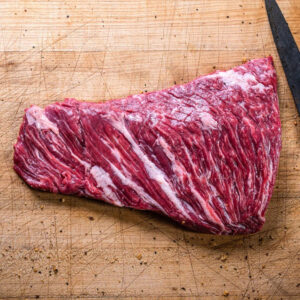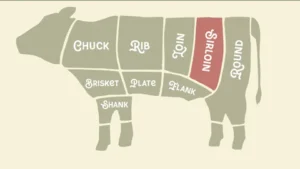
Where does the Bavette steak come from?
Bavette steak comes from the sirloin primal – more specifically, it’s a cut that comes from the bottom sirloin, and is located adjacently to the flank steak. This cut’s grain and muscle fibers are quite loose looking – there’s clear space in between grain fibers, especially compared to some other beef cuts. This is a nice feature in the sense that rubs and marinades tend to really soak into the cut.
What’s in a name?
The Bavette can also be called the “flap steak” and is sometimes confused with the flank steak because they’re located so close together, but they are not the same cut.

But how do I cook it?
When it comes to cooking your Bavette steak, there are just a few important factors to remember!
Like the more common cuts of beef, it should be cooked until the internal temperature reaches 145 °F whether you’re grilling, pan-cooking, or roasting in your oven.
Once cooking is done, do not forget to let the steak rest for approximately 10-15 minutes before cutting.
This allows the juices to redistribute throughout the steak.
Always, always cut against the grain!
Look at the direction the fibers in the meat run, and cut in the opposite direction with a sharp knife.
Bavette Steak is a versatile cut that can be delicious across a wide variety of preparation methods.
Most commonly, it’s seasoned with a dry rub or just simply salt and pepper.It’s also very accepting of marinades as the openness of its fibers really allows the beef to soak up seasoning and marinade.
The best bavette steak has solid marbling throughout the meat.
But how do I cut it?
Using a sharp knife, you will then need to cut against the grain. Doing so will leave the meat more tender. The “grain” is a term that is used to identify the direction in which the muscle fibers of the meat lie.
Typically, you will be making your cuts widthwise rather than lengthwise.
The size of the slices will depend on how you are going to be eating your bavette steak. If it is going to be used in fajitas it will need to be cut into smaller chunks that are easily digestible when mixed with the other ingredients. Alternatively, you may choose to cut the meat into more substantially sized steak portions.
How you serve your steak will depend on how you like it. Bavette steak is best served rare, medium-rare, or medium, and sliced into thin pieces for a tender and juicy result.
When grilled, bavette is best served in fajitas, steak enchiladas, or on its own with a flavorful sauce such as chimichurri or herb-butter on the side.
If you’re not trying the lesser-known cuts of meat you’re seriously missing out. By branching out and trying other cuts of meat, you’re blessed with the best of both worlds. Not only are you greeted with a more affordable price, but you’re also treated to unbelievable flavors.
The story of the Bavette is the same as the Roseda story – you have to taste it to believe it!